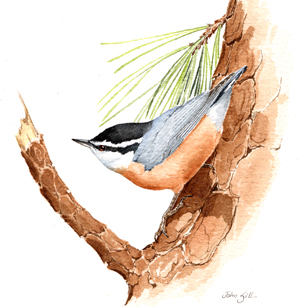Find a Bird
Red-breasted Nuthatch
Sitta canadensis

Fairly widespread and likely increasing
“The little birds seem so happy, animated, and lively and their voices have such a range of expression that they almost talk – a playful gathering of talkative, irrepressible, woodland gnomes.” – Winsor Marrett Tyler, in Arthur Cleveland Bent’s Life Histories of North American Birds
Casual observers of nature do not take long to discover nuthatches, whose habit of descending tree trunks headfirst entertain and amuse even the most stolid naturalist. Though their daring climbs are motivated primarily by a hunger for insects, which they pick from the bark, they often come to feeders in the winter to take advantage of offered seeds. Although the Red-breasted Nuthatch’s cousin, the White-breasted Nuthatch, is generally more common, the Red-breasted Nuthatch associated with northern forests retains a greater breeding presence in Massachusetts than was once believed.
Historic Status
By all accounts, the Red-breasted Nuthatch, previously known as the Red-bellied Nuthatch or the Canada Nuthatch, held firmly if sparingly to breeding grounds in Berkshire County during the 1800s. At that time, Henry Davis Minot stated that October was the best month to see a Red-breasted Nuthatch in eastern Massachusetts, when they became “quite common” around Boston (Minot 1877). By 1900, several observers noted sporadic breeding in the eastern half of the state, including William Brewster, who received a report of a nest in Needham (Brewster 1906), and Howe and Allen (1901), who listed them in “Ware, Winchendon, Plymouth County, Bolton, Beverley [sic], Medford and Needham.” Still, when tasked with defining their status for his Birds of Massachusetts and Other New England States in the late 1920s, Forbush considered the species to be an “Irregular fall or winter visitor or winter resident; uncommon summer resident on higher lands of western counties...” (Forbush 1929). Nonetheless, range expansion was obviously taking place.
Atlas 1 Distribution
Red-breasted Nuthatches were unprecedentedly widespread within the Bay State at the time of Atlas 1. The traditional Berkshire strongholds of the species still had plenty of birds, especially the Marble Valleys (51% block occupancy) and Berkshire Highlands (76% block occupancy). The Lower Berkshire Hills and the Connecticut River Valley, with fewer stands of mature conifers, were less appealing to Red-breasted Nuthatches. The Worcester Plateau had significantly greater block occupancy than the Lower Worcester Plateau, as befit its higher altitude and more nuthatch-friendly conifer forests. Red-breasted Nuthatches were present in 25% or more of blocks in the Coastal Plains and the Boston Basin, representing a significant eastward colonization. Even the Bristol/Narragansett Lowlands and Cape Cod and Islands had breeding nuthatches as far east as Provincetown and Nantucket.
Atlas 2 Distribution and Change
By the time of Atlas 2, the intrepid Red-breasted Nuthatch had covered nearly half of the Massachusetts landmass. The expansion generally happened in the east, with Cape Cod and the Islands bearing the brunt of the invasion force’s alarm-clock songs. Red-breasted Nuthatches appeared anew in 28% of the region, perhaps a sign that the great pine barrens of southeastern Massachusetts had finally come of age, at least in the minds of the nuthatches. The Worcester Plateau and the Lower Berkshire Hills also showed strong evidence of expansion, with new nuthatches in a third of their blocks or more.
Atlas 1 Map

Atlas 2 Map

Atlas Change Map

Ecoregion Data
Atlas 1 | Atlas 2 | Change | ||||||
Ecoregion | # Blocks | % Blocks | % of Range | # Blocks | % Blocks | % of Range | Change in # Blocks | Change in % Blocks |
Taconic Mountains | 7 | 43.8 | 2.3 | 4 | 16.0 | 0.8 | -4 | -26.7 |
Marble Valleys/Housatonic Valley | 20 | 51.3 | 6.6 | 21 | 53.8 | 4.2 | 1 | 2.6 |
Berkshire Highlands | 42 | 76.4 | 13.8 | 47 | 85.5 | 9.3 | 5 | 9.4 |
Lower Berkshire Hills | 8 | 28.6 | 2.6 | 21 | 67.7 | 4.2 | 13 | 48.1 |
Vermont Piedmont | 7 | 41.2 | 2.3 | 6 | 35.3 | 1.2 | -1 | -8.3 |
Berkshire Transition | 13 | 34.2 | 4.3 | 25 | 62.5 | 5.0 | 6 | 19.4 |
Connecticut River Valley | 14 | 25.0 | 4.6 | 30 | 46.2 | 5.9 | 11 | 22.9 |
Worcester Plateau | 37 | 47.4 | 12.1 | 78 | 88.6 | 15.4 | 16 | 33.3 |
Lower Worcester Plateau | 24 | 32.4 | 7.9 | 47 | 58.8 | 9.3 | 13 | 24.1 |
S. New England Coastal Plains and Hills | 72 | 26.7 | 23.6 | 124 | 43.8 | 24.6 | 30 | 13.3 |
Boston Basin | 14 | 25.0 | 4.6 | 18 | 32.1 | 3.6 | 4 | 7.3 |
Bristol and Narragansett Lowlands | 18 | 17.0 | 5.9 | 18 | 15.8 | 3.6 | 0 | 0.0 |
Cape Cod and Islands | 29 | 21.3 | 9.5 | 66 | 45.8 | 13.1 | 33 | 27.5 |
Statewide Total | 305 | 31.5 | 100.0 | 505 | 48.7 | 100.0 | 127 | 15.3 |
Notes
The Red-breasted Nuthatch shows a significant increasing Breeding Bird Survey trend in the Eastern US overall.



